
Latest release focuses on aiding developer and manufacturer innovation
The Bluetooth SIG (Special Interest Group) announced today all of the new features coming with the latest release of the standard, Bluetooth 4.1. As you would expect with an incremental point release the bump to BT 4.1 isn’t groundbreaking, but makes several solid improvements over 4.0.
The latest version focuses first in improving usability for end users — the BT SIG has worked to make sure Bluetooth and LTE radios can cooperate and not interfere with each other’s transmissions in a device. The latest spec also lets manufacturers have more control over Bluetooth connections in terms of reconnection times and disconnect thresholds.
A big part of BT 4.1 is making it easier for developers to use the technology. Working to be at the center of the “Internet of Things,” Bluetooth 4.1 lets any device be both a peripheral and a hub at the same time — for example a smartwatch could be a peripheral to a phone, but also be a hub to other peripherals such as a heart monitor or pedometer.
The Bluetooth SIG certainly sees even more potential in its technology, and with the new technological advances in 4.1 the spec is getting even more powerful.
Updated Bluetooth® 4.1 Extends the Foundation of Bluetooth Technology for the Internet of Things
New Features Improve Usability for Consumers and Empower Innovation for Product Developers
Kirkland, Washington – December 04, 2013 – The Bluetooth Special Interest Group (SIG) today announced the adoption of updates to the Bluetooth Core Specification. Bluetooth 4.1 is an important evolutionary update to the wireless specification, which experienced a revolutionary update in July 2010 with Bluetooth Smart, the intelligent, low-energy technology enabling the Internet of Things (IoT). The updates will improve consumer usability with increased co-existence support for LTE, bulk data exchange rates, and aid developer innovation by allowing devices to support multiple roles simultaneously. The new release also lays the groundwork for IP-based connections, extending Bluetooth technology’s role as the essential wireless link for the IoT.
“Bluetooth Smart technology put us on a rocket ship of growth, with Bluetooth annual product shipment projections skyrocketing to more than 4.5 billion in the next five years,” said Suke Jawanda, Bluetooth SIG CMO. “We updated the Bluetooth specification to address this projected growth, making changes to give developers more control in assigning a role to their product, limiting interference with other wireless technologies, and allowing Bluetooth Smart products to exchange data faster and maintain connections with less manual intervention. These updates reflect the demand we see in the market. We will continue to sculpt Bluetooth wireless technology to extend its critical role in enabling the Internet of Things and ensure it is the very best solution for OEMs, developers and, ultimately, consumers.”
Improving Usability
Bluetooth 4.1 extends the Bluetooth brand promise to provide consumers with a simple experience that “just works.” Major usability updates come in three areas:
· Coexistence — engineered to work seamlessly and cooperatively with the latest generation cellular technologies like LTE. Bluetooth and LTE radios can communicate in order to ensure transmissions are coordinated and therefore reduce the possibility of near-band interference. The coordination between the two technologies happens automatically, while the consumer experiences the high quality they expect.
· Better Connections — provides manufacturers with more control over creating and maintaining Bluetooth connections by making the reconnection time interval flexible and variable. This improves the consumer experience by allowing devices to reconnect automatically when they are in proximity of one another. The consumer can leave the room and upon returning, two recently used devices reconnect without user intervention.
· Improved Data Transfer — Bluetooth Smart technology provides bulk data transfer. For example, through this new capability, sensors, which gathered data during a run, bike ride or swim, transfer that data more efficiently when the consumer returns home.
Empowering Developer Innovation
Bluetooth 4.1 extends the Bluetooth Smart development environment by providing product and application developers with even more flexibility to create products that can take on multiple roles. With this new capability, a single device acts as both a Bluetooth Smart peripheral and a Bluetooth Smart Ready hub at the same time. For example, a smart watch acts as a hub gathering information from a Bluetooth Smart heart rate monitor while simultaneously acting as a peripheral to a smartphone — displaying new message notifications from the phone. As the Bluetooth Smart ecosystem grows, the Bluetooth SIG expects more solutions to play both a hub and peripheral role. Bluetooth 4.1 delivers this type of flexibility to Bluetooth Smart devices and application developers.
Enabling the Internet of Things
By adding a standard means to create a dedicated channel, which could be used for IPv6 communications in the Core Specification, the groundwork is laid for future protocols providing IP connectivity. With the rapid market adoption of Bluetooth Smart and the coming addition of IP connectivity, all signs point to Bluetooth as a fundamental wireless link in the Internet of Things. These updates make it possible for Bluetooth Smart sensors to also use IPv6, giving developers and OEMs the flexibility they need to ensure connectivity and compatibility.
For the latest Bluetooth 4.1 technical details, tools and other information including an FAQ, brand guide and more, visit: https://www.bluetooth.org/en-us/specification/adopted-specifications
About Bluetooth® Wireless Technology
Bluetooth wireless technology is the global wireless standard enabling simple, secure connectivity for an expanding range of devices and serves as the backbone of the connected world. Bluetooth Smart technology, through an updatable platform and low power consumption, creates new application opportunities for the mobile phone, consumer electronics, PC, automotive, health & fitness and smart home industries. With over two billion devices shipping annually, Bluetooth is the wireless technology of choice for developers, product manufacturers, and consumers worldwide. Backed by industry leading companies, the Bluetooth SIG empowers over 20,000 member companies to collaborate, innovate and guide Bluetooth wireless technology. For more information, please visit www.bluetooth.com.